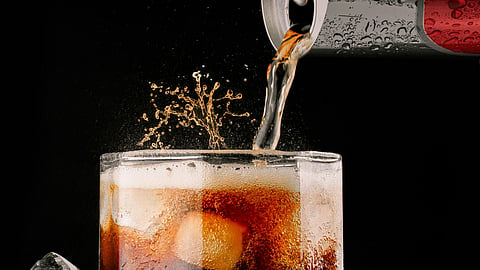Are Prebiotic Sodas a Healthier Alternative for Kids?
Numerous studies emphasize the adverse health impacts of sugar on children. However, with the increasing popularity of prebiotic sodas such as Olipop and Poppi, the question arises: Are these prebiotic, fizzy drinks any healthier?
Many of these beverages are known to contain less sugar and calories than traditional soda, and often claim to support the gut microbiome. This is attributed to the presence of inulin, a prebiotic form of fiber – prebiotic sodas contain 2-5 grams of fiber per can.
However, there is still a significant amount of sugar in these drinks – 5 grams or less per can – which may prompt parents to reconsider making them a frequent choice for children.
Danielle Mein, RD, a pediatric dietician at UCLA Health, addresses some of the most common questions about the potential health benefits of substituting traditional sodas with prebiotic sodas, for children (and adults, too).
What are the main differences between prebiotic and traditional sodas regarding ingredients and nutritional content?
Mein: Prebiotic sodas are much lower in calories, significantly lower in added sugars, and much more nutritious than traditional sodas.
How do prebiotic sodas benefit gut health, and are these benefits significant enough to outweigh any potential drawbacks?
Mein: Prebiotic sodas contain ingredients that have a prebiotic function, such as Jerusalem artichoke, chicory, cassava, etc. Prebiotics essentially feed the “good bacteria,” aka probiotics, in the gut, mainly in the colon, meaning they stimulate the growth of probiotics. Increasing probiotics in the gut can be beneficial since a healthy microbiome supports the immune system, improves digestion, reduces inflammation, and more. We are still learning all the roles of probiotics in the human body.
The positive effects of consuming a prebiotic soda that is much lower in sugar than standard sodas can be a significant and beneficial change for someone who has routinely been drinking traditional sodas. Switching from drinking a traditional soda daily to a prebiotic soda will ultimately greatly benefit one’s health. However, it is not advisable to add prebiotic sodas to a diet that is already soda-free.
What are the potential concerns regarding using apple cider vinegar (as an ingredient) and artificial sweeteners in prebiotic sodas, especially concerning children’s health?
Mein: Consumption of apple cider vinegar can cause indigestion for some; however, this is typically in more significant volumes than what is included in prebiotic sodas. The amount in prebiotic sodas is likely of very little to no concern for children.
However, the routine use of artificial or alternative sweeteners for children, especially in beverages, is not recommended. Consuming artificial or alternative sweeteners in a beverage can still result in the body responding similarly to ingesting regular sugar. So though these are touted as no- to low-calorie sweeteners, they still result in a similar response in the body; we taste something sweet, which then activates what is called the cephalic phase of digestion, resulting in insulin secretion, just as if we consumed regular sugar. If this occurs daily, between meals significantly, it can contribute to insulin resistance and, ultimately, weight gain. Regarding artificial sweeteners specifically, some studies have shown that the regular consumption of artificial sweeteners is associated with cancer risk.
Finally, another concern is the routine consumption of beverages sweetened with artificial or alternative sweeteners that, in general, can shape a child’s taste preferences – the more children get accustomed to drinking a sweet-tasting drink, the more they will likely crave and desire this. This is not a healthy habit to instill long term, despite the benefits of prebiotics, since prebiotics can also be consumed from food sources such as garlic, oats, asparagus, onions, bananas, and more.
Regarding caffeine content, how does it vary among different flavors of prebiotic sodas, and what are the recommended guidelines for children’s caffeine consumption?
Mein: Some prebiotic sodas contain 30-50 mg of caffeine per serving, about 1/3-1/2 of a cup of coffee. The American Academy of Pediatrics recommends that children under 12 avoid caffeine entirely and that children ages 12–18 limit caffeine to less than 100 mg daily.
Can you give parents tips on how to incorporate prebiotic sodas into their child’s diet in a balanced and healthy way?
Mein: If your child regularly consumes traditional sodas, prebiotic sodas can be a beneficial tool in improving your child’s diet. They can gradually replace traditional sodas as your child learns healthier habits in the long term. Since prebiotic sodas are generally more costly than traditional sodas, this can be a “blessing in disguise” to ultimately reduce the volume or frequency of soda consumption in the long run.
As a pediatric dietitian, I always recommend that families work on gradual changes in a child’s diet to ensure realistic, feasible changes that result in lasting change versus short-term, unsustainable, drastic changes. So instead of, for instance, completely cutting your child’s daily soda habit, a traditional soda can be replaced with a prebiotic soda every other day or a few times per week and then gradually reduced from there over time as they learn to drink more water primarily.
In additional to regular water, are there any alternative beverages or strategies you recommend for parents concerned about their child’s soda consumption but unsure about prebiotic sodas?
Mein: Another option is to try sparkling or seltzer water of different varieties. Some are flavored with natural flavors; others have real juice included. You can also purchase plain seltzer water and add your own real juice in varying ratios based on what your child prefers, and then slowly reduce the juice over time to help your child adjust to a less sweet taste.
Are there any additional resources or research studies you would recommend for parents who want to learn more about the safety and benefits of prebiotic sodas for children?
Mein: www.healthychildren.org has some helpful tips about prebiotics for kids; however, the information is generally limited due to a lack of research.
(Newswise/GS)


